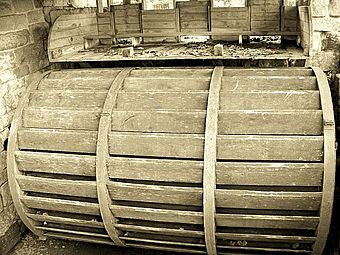Gaston's Mill-Lock No. 36, Sandy and Beaver Canal District facts for kids
Quick facts for kids |
|
|
Gaston's Mill-Lock No. 36, Sandy And Beaver Canal District
|
|

Water wheel at Gaston's Mill
|
|
| Nearest city | Clarkson, Ohio |
|---|---|
| Area | 12 acres (4.9 ha) |
| Built | 1834 |
| Architect | Samuel Conkle |
| NRHP reference No. | 74001423 |
| Added to NRHP | May 23, 1974 |
The Gaston's Mill-Lock No. 36, Sandy and Beaver Canal District is a special historical area. It is listed on the National Register of Historic Places because of its importance. You can find this district inside Beaver Creek State Park, about one mile south of Clarkson, Ohio.
Gaston's Mill was built in 1837. It used the power of Little Beaver Creek to grind grains. Lock 36 was one of 90 locks on the Sandy and Beaver Canal. Building this canal started in 1834 and finished in 1848.
Work to fix up the mill began in 1964. Today, it still grinds whole wheat flour, corn meal, and buckwheat flour. Gaston's Mill is the only working water-powered grist mill in Columbiana County. The rebuilding of Lock 36 started in 1988 and was completed in 1991. The lock was restored to show how these structures helped boats move along the canal.
Contents
History of Gaston's Mill and Lock 36
How Gaston's Mill Was Built
Samuel Conkle built Gaston's Mill around 1837. It was on land that belonged to his father, Jacob. Samuel took over the land in 1843 after his father passed away. Conkle used the mill to grind many types of grains, like corn, wheat, oats, and buckwheat.
In 1849, Samuel sold the mill and its land to James Gaston. The mill is named after Philander Gaston, James's son. Philander owned the mill for a longer time than anyone else. The mill used water power until Gaston sold it in 1886. After that, it changed to steam power, then to gasoline power. The mill kept working until World War I. At its busiest, the mill made almost 200 pounds of flour every day.
The Sandy and Beaver Canal
Lock 36 was one of 90 locks on the Sandy and Beaver Canal. This canal was built between 1828 and 1848. Canals are like man-made rivers that help boats travel. The Sandy and Beaver Canal was a "feeder" canal. This means it connected to a bigger canal called the Ohio and Erie Canal.
Bringing History Back to Life: Restoration Efforts
Restoring Gaston's Mill
The Columbiana Forests and Park Council helped fix up the mill. This group is now called the "Friends of Beaver Creek State Park." The restoration work started in January 1964. Lorin Cameron led the project to bring the mill back to life.
During the rebuilding, workers straightened the building. They replaced old wood beams in the basement. The mill's outer walls and some floors were also replaced. A new shingle roof was put on. The shingles for the roof were made using an old shingle machine from 1857. Most of the large wood timbers and posts in the mill are still the original ones.
Rebuilding Lock 36
The restoration of Lock 36 began in 1988 and finished in 1991. The special wooden gates for the lock were built during a workshop. This workshop was held right at Beaver Creek State Park. The builders, Christian & Son Timber, used tools from the 1800s. They even dressed like craftsmen from that time!
Today, the fixed-up mill and lock are part of Pioneer Village. This village is in Beaver Creek State Park. The "Friends of Beaver Creek State Park" group runs the village, and visitors can explore it.
Why This Place Is Important
The Gaston's Mill-Lock No. 36, Sandy And Beaver Canal District was added to the National Register of Historic Places in May 1974. It was chosen because it played a big part in history. The district also shows special ways of building from a long time ago. It is important because it is one of the few mills left from that era. Many years ago, there were six mills along the route from Elkton and Fredericktown. But Gaston's Mill is the only one that remains today.
Images for kids





